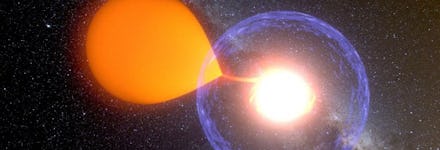We just got our first complete look at an exploding white dwarf star

For the first time ever, scientists have captured the full process of a nova explosion — the moments before, during and after the blast.
Nova explosions are different from supernovas because the star isn't completely destroyed. Novas happen in two-star systems, when a white dwarf star has been sucking in mostly hydrogen gas from a close neighboring star. The extra hydrogen explodes, but the explosion only happens on the star's surface.
Back in 2009, the white dwarf in a star system called V1213 Cen exploded. But astronomers at the University of Warsaw had been closely monitoring the star since 2003, so they could go back and witness the build-up to the explosion.
We know a lot about the after-effects of exploding stars, but we rarely get to see the moments leading up to an explosion. In this case, astronomers got the first visual confirmation of what happens before and after a nova explosion. The research is published in the journal Nature.
This is the first evidence we have that binary stars like these have hibernation periods, where the white dwarf star sucks in more material right after the explosion then gradually slows down. Astronomers think this creates a kind of cycle of explosions, and that's exactly what they saw while studying V1213 Cen.
From 2003 to 2009, the white dwarf in the star system would periodically brighten when it sucked in a chunk of hydrogen from its neighbor, but the transfer was happening very slowly. Then after the explosion, the star swelled and started sucking hydrogen faster.
The white dwarf will probably explode again, according to the research. But since the cycle happens over millions of years, we won't get to see it.